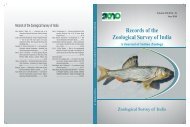Andaman booklet aw.FH10 - Zoological Survey of India
Andaman booklet aw.FH10 - Zoological Survey of India
Andaman booklet aw.FH10 - Zoological Survey of India
You also want an ePaper? Increase the reach of your titles
YUMPU automatically turns print PDFs into web optimized ePapers that Google loves.
identifiable groups. Of these, only thirteen are inhabited. The<br />
northern section has two islands: Car Nicobar and to its south, the<br />
small island <strong>of</strong> Battimalv. Car Nicobar is the headquarters <strong>of</strong> Nicobar<br />
district. The middle section <strong>of</strong> the group is made up <strong>of</strong> nine islands,<br />
with Chowra, Teressa, Bompoka and Katchall to the west, and<br />
Nancowry, Camorta, and Trinket to the east. Tillangchong and the<br />
Isle <strong>of</strong> Man lie slightly to the northeast. The southern section consists<br />
<strong>of</strong> two large islands, Little and Great Nicobar, together with the eight<br />
smaller islands <strong>of</strong> Meroe, Trak, Treis, Pulo Milo, Kabra, Menchal,<br />
Kondul and Megapode which are smaller islands (Saldhana, 1989).<br />
Table 1. Geographical and physical pr<strong>of</strong>ile <strong>of</strong> <strong>Andaman</strong> and<br />
Nicobar Islands<br />
Total Area 8,249 km 2<br />
Area <strong>of</strong> <strong>Andaman</strong> District 6,408 km 2<br />
Area <strong>of</strong> Nicobar District 1,841 km 2<br />
Latitude 6°45' N to 13°41' N<br />
Longitude 92°12' E to 93°57' E<br />
Mean annual rainfall 3180.5 mm<br />
Average relative humidity 77%<br />
Coastline 1,962 km<br />
Exclusive Economic Zone 600,000 km 2<br />
Ecosystems<br />
An extraordinary variety <strong>of</strong> habitat types, ranging from sandy beaches<br />
to coral reefs, mangroves, and mountains with dense forests,<br />
characterize the <strong>Andaman</strong> and Nicobar Islands. They are located in<br />
the equatorial belt and have been endowed with an abundance <strong>of</strong><br />
flora and fauna. A number <strong>of</strong> species are endemic and restricted to<br />
small areas because <strong>of</strong> the islands' geographic isolation.<br />
The land area <strong>of</strong> the island chain is restricted but the diversity <strong>of</strong><br />
forest types, each with its own distinctive floral and faunal<br />
composition, is staggering. Some <strong>of</strong> the larger islands display a<br />
veritable mosaic <strong>of</strong> forest types. The tropical forest ecosystem<br />
continuously recycles water. Since most <strong>of</strong> the islands have very few<br />
perennial rivers and streams, the inland wetlands are restricted.<br />
Basically, small ponds formed by rainwater accumulate inside the<br />
forests. The ponds are valuable sources <strong>of</strong> freshwater for wildlife<br />
and they also serve as a refuge for endangered species, such as the<br />
04<br />
Source: Pande et al. (1991)
















